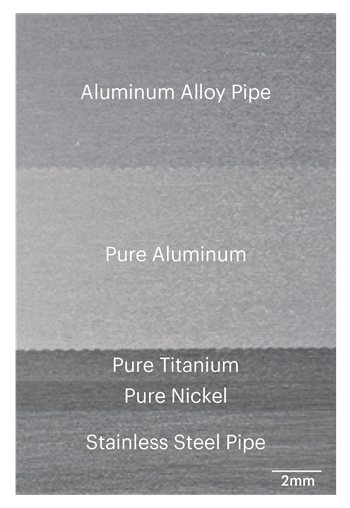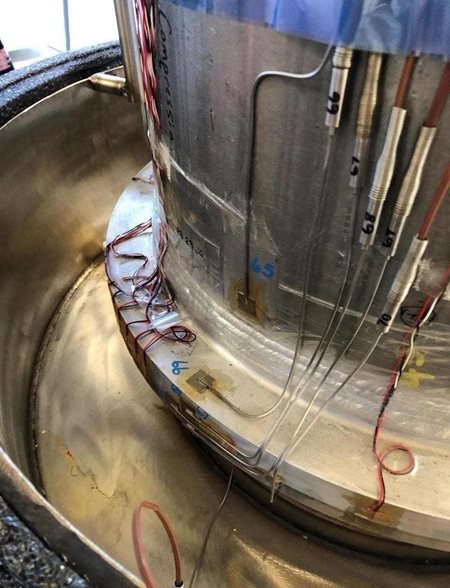When our customers are faced with complex challenges regarding materials, engineering design, or constructability they want immediate, actionable answers. Our project teams comprised of engineers, construction specialists, and craftworkers at Bechtel’s Welding and Applied Technology Center (WATC) deliver solutions. The Center is a construction technology hub located in Houston, Texas, housing welding, mechanical testing, and materials evaluation laboratories to solve our customers’ and partners’ challenges.
Earlier this year, a customer approached us to partner in solving an issue regarding a unique and complex pipe component that failed prematurely while in service. Answers to why the pipe component failed and how to avoid future failures was critical.

Figure 1 A piping transition joint changes the pipe material from an aluminum to stainless steel alloy using three intermediate material layers
Our technical and subject matter experts used the best equipment, tools, and facilities to find out why the transition joint failed. As illustrated in Figure 1, a transition joint is a prefabricated, non-separable, metallurgically bonded joint used for field butt welding of dissimilar metal piping components that are not weldable to each other. Typical metals include aluminum to stainless steel for cryogenic applications. Immediate discussion began with our engineering and project team to understand the transition joint location, thermal and mechanical history, and historical evolution of liquified natural gas (LNG) process plants over the past few decades.
The team jumped in with a plan for materials analysis, testing, and evaluation of the properties. They rapidly designed a full-size mock-up and conducted experiments to analyze strain gauge data on each material during cryogenic thermal shock and mechanical loading.
Welding and materials characterization of engineering structures is complicated and having a physical workspace to complete advanced testing and analysis of welding, materials, and construction technology is critical to properly develop a solution. The WATC teams’ design of experiments included a large mock-up simulation, full-scale mechanical testing, failure analysis, and non-destructive evaluation. Figure 2 provides a photograph of the physical mock-up.
During the transition joint analysis, the WATC served as a central hub for hands-on discussions with the customer and component manufacturer. Open discussion and analysis allowed us to identify the root cause analysis efficiently.

Figure 2 Physical mock-up of the transition joint simulating operating conditions with installed strain gauges, and thermocouples for analyzing the material response to cryogenic and mechanical loading
Testing for Solutions
Non-Destructive Evaluation (NDE): The five material layers made the internal inspection a real challenge. The WATC team used both Digital Radiography Techniques (RT) and Ultrasonic Techniques (UT) to internally inspect the joint. Through iterative testing and trials, they developed a new UT inspection technique shown in this video below. By inspecting the materials inside without cutting it apart, we were able to better understand the defect location and develop a UT inspection method applicable for both shop and field.
Materials Testing & Evaluation
Mechanical testing is commonly deployed to understand material properties and characteristics. Various types of mechanical tests were employed in understanding the transition joint properties.
Tension Testing: Provides the yield and tensile strength of a material. The sample is pulled to failure under a constant strain rate and produces an engineering stress-strain curve.
Impact Testing: Measures a material’s fracture toughness and is completed by Charpy V-notch testing under a high strain rate of impact. Testing can be performed down to liquid nitrogen temperatures at -320°F (-196°C).
Bend Test: Measures the material’s ductility by bending a cross-section of the welded plate around a 180° angle.
Micro-hardness Testing: Vickers microhardness mapping was completed on the transition joint. The fine, diamond indenter measures small material changes that occur during manufacturing.
Microstructure: Common construction materials like carbon steel, stainless steel, nickel, and aluminum alloys are composed of multiple chemical elements. Revealing the makeup of a material can strongly influence physical properties like strength, toughness, hardness, and more.
Additional WATC services
Welding procedure development
New welding procedures are continually needed and improved upon. New materials, new welding processes, novel construction applications, and advanced testing protocols create a need for additional welding procedures to be developed. No two projects are the same, which produces a range of requirements based on type of project, Construction Code, customer needs, and environmental conditions. Our projects utilize arc welding, stud welding, explosion welding, friction welding, and thermite welding either on-site or from our manufactured component vendors.
Welder qualification and training
With 14 state-of-the art welding booths, WATC engineers provide qualification testing for new welders seeking employment on our projects. Manual, mechanized, and automated welding equipment are available on-site to weld any type of material.
Bechtel’s two specialty welding companies, Custom Arc Services and Master Craft Inc a United Association and open shop organization respectively, are headquartered on-site, providing more SMEs within the WATC to help solve our customers’ and partners’ problems.
Industry-recognized welding training
WATC also uses Bechtel’s welding engineers to provide industry-standard training for inspectors and engineers through the American Welding Society’s Certified Welding Inspector and Certified Radiographic Interpreter seminars and exams. Having this has been helpful to provide continuing education to our welding engineers and to ensure they receive top training to succeed throughout their careers.
Every day, Bechtel specialists work toward developing solutions to answer some of the most difficult challenges our customers face. We have the physical space, specialized tools, and subject matter experts to deliver value to our partners, customers, and the construction industry as a whole. This collaborative nature not only contributes to the success of our partners and clients, but also advances the industry standards necessary to build the projects of the future.
If you have any questions, think you or your organization might benefit from the services we offer, or would just like to learn a little more about what we do, we encourage you to contact one of our representatives below and we’d be glad to assist you.
Ben Pletcher
Chief Welding Technologist
[email protected]
Robert May
Corporate Manager of Welding
[email protected]

